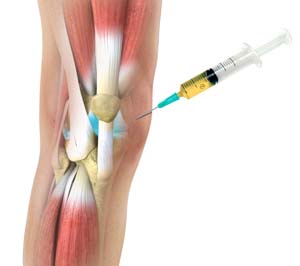Comprehending the Advantages of Human Umbilical Cable Tissue Injection for Joint Pain Relief

Joint pain is an extremely typical concern that can have a big effect on a person's lifestyle. In the past, people would have to rely on the use of prescription medications and even surgical treatment to help reduce the pain and discomfort related to joint pain. However, nowadays, there is a a lot more natural and reliable method to deal with joint discomfort. Platelet Rich Plasma (PRP) treatment has actually ended up being significantly popular over the past couple of years and is getting acknowledgment as a feasible treatment option for joint pain. This extensive guide will supply an overview of PRP treatment and how it can help treat joint discomfort. It will cover whatever from how PRP works to the different types of PRP treatments available, as well as the prospective advantages and threats associated with this technique of treatment. By the end of this guide, you will have a better understanding of PRP treatment and how it can be used to successfully treat joint pain.
What is Platelet Rich Plasma (PRP) Therapy?
PRP treatment is a treatment that includes drawing out a sample of blood from the patient, separating the platelets within the blood, and then re-injecting the platelets back into the client's hurt or painful joint. Basically, the platelets are what make PRP therapy so reliable. Platelets are naturally happening blood parts that are rich in development aspects. Growth aspects are proteins that stimulate cellular regrowth and tissue repair, which is why they are used in so many different types of medical treatments. By extracting the platelets out of the patient's blood sample and re-injecting them back into the client's hurt joint, they are essentially supplying their body with the required proteins needed to start the healing procedure. This procedure can assist deal with a range of various conditions and injuries such
How Does PRP Treatment Work?
When the platelets are drawn out from the client's blood sample and re-injected back into the patient, they promote the healing procedure in the client's injured joint. The development elements within the platelets are what are accountable for promoting this recovery procedure. Essentially, the platelets function as little bio-factories that produce proteins which help to promote the recovery procedure and speed up recovery time. As the platelets are re-injected back into the client's hurt joint, they activate the body's own recovery procedure and help to decrease the discomfort and inflammation associated with the injury. They also assist to promote a more fast healing procedure, resulting in less down-time periods and a quicker go back to routine daily activities. By dealing with joint pain with PRP therapy, you can help reduce joint discomfort, increase movement, and speed up your healing time.

What are the Advantages of PRP Therapy for Joint Discomfort?
As PRP treatment is so effective at reducing joint pain, pain, and inflammation, it is the perfect treatment option for anybody who is suffering from joint pain. PRP therapy has the ability to minimize the pain and discomfort related to joint pain by promoting the body's own recovery procedure and naturally speeding up the rate of recovery time. PRP therapy is also incredibly successful at assisting to increase movement in the affected joint and minimizing the risk of tightness and swelling. As the body's recovery procedure is naturally accelerated, you will likely find that your joint discomfort subsides far more rapidly and you will be able to go back to your routine daily activities faster than you would if you were to rely on prescription medications. PRP treatment is a a lot more natural and reliable technique to treating joint pain, and is incredibly useful because it is minimally invasive and does not require any down period.

What are the Various Kinds Of PRP Treatments for Joint Discomfort?
For each individual, there are different kinds of PRP treatments that can be used for dealing with joint discomfort. For instance, if you are struggling with knee pain, you could select a PRP injection into your knee joint. This treatment can be used to treat a variety of conditions consisting of: arthritis, osteoarthritis, rheumatoid arthritis, joint separation, muscle sprains, and tendonitis. There are likewise different kinds of PRP injections that can be used to treat various areas of the body, consisting of the knees, shoulders, elbows, and wrists.
What are the Potential Threats and Side Effects of PRP Treatment?
As PRP treatment is a natural and reliable method to treat joint discomfort and accelerate the healing process, it is exceptionally safe and comes with really few side effects or dangers. Essentially, PRP treatment is only using the patient's own blood and there are virtually no threats connected with PRP. Although PRP treatment is exceptionally safe and effective, there are some things to be aware of prior to undergoing the treatment. PRP treatment might take a little longer to begin working as it is a more natural and slower process than taking medications. It is important to bear in mind that not everyone will respond to PRP therapy, and it is very important to discuss your alternatives with your medical professional.
platelet rich plasma therapy for back pain
How to Prepare for PRP Treatment?
Prior to you arrange a consultation for PRP treatment, it is very important to make sure that it is the right treatment choice for you. PRP treatment is best matched for individuals who are suffering from chronic pain or discomfort that is brought on by an injury or a specific condition. For example, if you have been detected with arthritis and experience a great deal of discomfort and discomfort in your knees and joints, PRP treatment could be an excellent option for treating your pain. Additional Info is minimally intrusive, so there is no requirement to worry about an invasive or risky surgical treatment. PRP therapy can also be used to deal with sports injuries and assist speed up the healing process. For PRP therapy, you will require to make sure that you are in good health and that your body has no existing health problems or infections. You will also require to make sure that you are not taking any blood thinning medications as these can disrupt the efficiency of PRP therapy.
What to Expect Throughout PRP Therapy?
PRP therapy is a fairly easy procedure that takes really little time to finish. The primary step while doing so is to draw blood from the patient and separate the platelets from the sample. The blood sample is positioned in a centrifuge and spun around to separate out the platelets and blood cells. Then, the platelets are re-injected back into the client's hurt joint and the blood cells are discarded. The entire treatment is exceptionally safe and painless, and is typically done as an outpatient procedure in a center or doctor's office. You will only require to be in the clinic for a couple of hours and you will have the ability to go home after the procedure and rest as you normally would. Depending on the kind of PRP treatment you are getting, there may be some moderate to moderate swelling, but this must diminish within a few days after the procedure.
What to Expect After PRP Therapy?
After you have actually gone through PRP therapy, you will likely see a practically instant enhancement in your joint discomfort and increased mobility. As the platelets are naturally healing your joint and accelerating the body's natural recovery procedure, you ought to see an enhancement within a couple of days. It is likely, nevertheless, that you will see the biggest distinction in between PRP treatment and regular medications after about a week. After PRP treatment, it is necessary to rest and permit your joint to recover, but you need to be able to go back to your regular day-to-day activities earlier than you would after taking a routine pain medication. Among the very best aspects of PRP treatment is that it doesn't need you to take any drugs, so you do not need to fret about prospective side effects or long-term health concerns.
What are the Expenses of PRP Treatment?
The expense of PRP therapy can differ depending upon the individual center or doctor's office where you pick to have actually the treatment performed. PRP treatment is a minimally intrusive procedure that is often finished as an outpatient procedure and does not need any down time. As such, PRP treatment is typically more budget friendly than lots of other treatment options. Depending on the clinic you go to and what kind of PRP therapy you get, the costs of PRP treatment can range from a few hundred dollars to a couple of thousand dollars. Remember that PRP therapy is a much more natural treatment choice that assists to speed up the body's own recovery procedure and is typically much safer and more budget friendly than taking prescription medications. As such, it is very important to do your research study and talk with your medical professional to figure out if PRP therapy is the best treatment option for you.
Today's arthritis medicine post has been made possible by Joint Repair Clinic of Montana.
Joint Repair Clinic of Montana is a regenerative medicine provider near Bozeman, MT. Joint Repair Clinic of Montana provides PRP treatment.
Joint Repair Clinic of Montana
804 N 19th Ave Ste 1B, Bozeman, MT 59718
(406) 522-9959
https://www.jointrepairmt.com/bozeman
